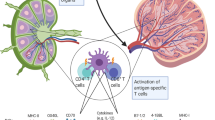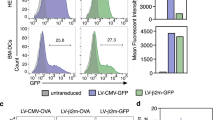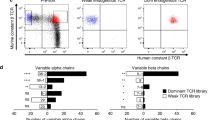Abstract
The induction of tumor-specific immune responses is largely dependent on the ability of dendritic cells (DCs) to present tumor-associated antigens to T lymphocytes. Therefore, we investigated the use of DC-associated promoter-driven genetic vaccines to specifically target DC in vivo. Restricted expression of vaccine-encoding genes in DC should enhance specificity and improves their safety for clinical applications. Hereto, 3–5 kb upstream sequences of the murine genes encoding CD11c, DC-SIGN, DC-STAMP and Langerin were isolated, characterized and subcloned into enhanced green fluorescent protein (EGFP) reporter constructs. Upon electroporation, EGFP was expressed in DC cell lines, but not in other cell lines, confirming DC-restricted promoter activity. When these promoters were cloned into a construct upstream of the gene for ovalbumin (OVA), it appeared that DC-STAMP promoter-driven expression of OVA (pDCSTAMP/OVA) in DC yielded the most efficient OVA-specific CD4+ and CD8+ T-cell responses in vitro. Administration of pDC-STAMP/OVA in vivo, using the tattoo gun vaccination system, evoked specific immune responses as evidenced in a mouse tumor model. Adoptively transferred pDC-STAMP/OVA-transfected DCs induced strong CD8+ T-cell proliferation in vivo. These experiments demonstrate that our DC-directed promoter constructs are potential tools to restrict antigen expression in DC and could be implemented to modulate DC function by the introduction of relevant proteins.
This is a preview of subscription content, access via your institution
Access options
Subscribe to this journal
Receive 12 print issues and online access
$259.00 per year
only $21.58 per issue
Buy this article
- Purchase on Springer Link
- Instant access to full article PDF
Prices may be subject to local taxes which are calculated during checkout






Similar content being viewed by others
References
Steinman RM, Hemmi H . Dendritic cells: translating innate to adaptive immunity. Curr Top Microbiol Immunol 2006; 311: 17–58.
Akbari O, Panjwani N, Garcia S, Tascon R, Lowrie D, Stockinger B . DNA vaccination: transfection and activation of dendritic cells as key events for immunity. J Exp Med 1999; 189: 169–178.
Porgador A, Irvine KR, Iwasaki A, Barber BH, Restifo NP, Germain RN . Predominant role for directly transfected dendritic cells in antigen presentation to CD8+ T cells after gene gun immunization. J Exp Med 1998; 188: 1075–1082.
Donnelly RF, Raj Singh TR, Woolfson AD . Microneedle-based drug delivery systems: microfabrication, drug delivery, and safety. Drug Deliv 2010; 17: 187–207.
Mahe B, Vogt A, Liard C, Duffy D, Abadie V, Bonduelle O et al. Nanoparticle-based targeting of vaccine compounds to skin antigen-presenting cells by hair follicles and their transport in mice. J Invest Dermatol 2009; 129: 1156–1164.
Mir LM . Nucleic acids electrotransfer-based gene therapy (electrogenetherapy): past, current, and future. Mol Biotechnol 2009; 43: 167–176.
Prow TW, Chen X, Prow NA, Fernando GJ, Tan CS, Raphael AP et al. Nanopatch-targeted skin vaccination against West Nile Virus and Chikungunya virus in mice. Small (Weinheim an der Bergstrasse, Germany) 2010; 6: 1776–1784.
Singh TR, Garland MJ, Cassidy CM, Migalska K, Demir YK, Abdelghany S et al. Microporation techniques for enhanced delivery of therapeutic agents. Recent Pat Drug Deliv Formul 2010; 4: 1–17.
Vandermeulen G, Daugimont L, Richiardi H, Vanderhaeghen ML, Lecouturier N, Ucakar B et al. Effect of tape stripping and adjuvants on immune response after intradermal DNA electroporation. Pharm Res 2009; 26: 1745–1751.
Babiuk S, Baca-Estrada ME, Foldvari M, Baizer L, Stout R, Storms M et al. Needle-free topical electroporation improves gene expression from plasmids administered in porcine skin. Mol Ther 2003; 8: 992–998.
Bennett AM, Phillpotts RJ, Perkins SD, Jacobs SC, Williamson ED . Gene gun mediated vaccination is superior to manual delivery for immunisation with DNA vaccines expressing protective antigens from Yersinia pestis or Venezuelan Equine Encephalitis virus. Vaccine 1999; 18: 588–596.
Dincer Z, Jones S, Haworth R . Preclinical safety assessment of a DNA vaccine using particle-mediated epidermal delivery in domestic pig, minipig and mouse. Exp Toxicol Pathol 2006; 57: 351–357.
Dresch C, Edelmann SL, Marconi P, Brocker T . Lentiviral-mediated transcriptional targeting of dendritic cells for induction of T cell tolerance in vivo. J Immunol 2008; 181: 4495–4506.
Geusens B, Strobbe T, Bracke S, Dynoodt P, Sanders N, Gele MV et al. Lipid-mediated gene delivery to the skin. Eur J Pharm Sci 2011; 43: 199–211.
Peachman KK, Rao M, Alving CR . Immunization with DNA through the skin. Methods (San Diego, Calif) 2003; 31: 232–242.
Steele KE, Stabler K, VanderZanden L . Cutaneous DNA vaccination against Ebola virus by particle bombardment: histopathology and alteration of CD3-positive dendritic epidermal cells. Vet Pathol 2001; 38: 203–215.
Sudowe S, Ludwig-Portugall I, Montermann E, Ross R, Reske-Kunz AB . Transcriptional targeting of dendritic cells in gene gun-mediated DNA immunization favors the induction of type 1 immune responses. Mol Ther 2003; 8: 567–575.
van den Berg JH, Nuijen B, Beijnen JH, Vincent A, van Tinteren H, Kluge J et al. Optimization of intradermal vaccination by DNA tattooing in human skin. Hum Gene Ther 2009; 20: 181–189.
Bonkobara M, Zukas PK, Shikano S, Nakamura S, Cruz Jr PD, Ariizumi K . Epidermal Langerhans cell-targeted gene expression by a dectin-2 promoter. J Immunol 2001; 167: 6893–6900.
Ross R, Sudowe S, Beisner J, Ross XL, Ludwig-Portugall I, Steitz J et al. Transcriptional targeting of dendritic cells for gene therapy using the promoter of the cytoskeletal protein fascin. Gene Ther 2003; 10: 1035–1040.
Sudowe S, Ludwig-Portugall I, Montermann E, Ross R, Reske-Kunz AB . Prophylactic and therapeutic intervention in IgE responses by biolistic DNA vaccination primarily targeting dendritic cells. J Allergy Clin Immunol 2006; 117: 196–203.
Geijtenbeek TB, Torensma R, van Vliet SJ, van Duijnhoven GC, Adema GJ, van Kooyk Y et al. Identification of DC-SIGN, a novel dendritic cell-specific ICAM-3 receptor that supports primary immune responses. Cell 2000; 100: 575–585.
Hartgers FC, Vissers JL, Looman MW, van Zoelen C, Huffine C, Figdor CG et al. DC-STAMP, a novel multimembrane-spanning molecule preferentially expressed by dendritic cells. Eur J Immunol 2000; 30: 3585–3590.
Valladeau J, Duvert-Frances V, Pin JJ, Dezutter-Dambuyant C, Vincent C, Massacrier C et al. The monoclonal antibody DCGM4 recognizes Langerin, a protein specific of Langerhans cells, and is rapidly internalized from the cell surface. Eur J Immunol 1999; 29: 2695–2704.
Winzler C, Rovere P, Rescigno M, Granucci F, Penna G, Adorini L et al. Maturation stages of mouse dendritic cells in growth factor-dependent long-term cultures. J Exp Med 1997; 185: 317–328.
Karttunen J, Sanderson S, Shastri N . Detection of rare antigen-presenting cells by the lacZ T-cell activation assay suggests an expression cloning strategy for T-cell antigens. Proc Natl AcadSci USA 1992; 89: 6020–6024.
Falo Jr LD, Kovacsovics-Bankowski M, Thompson K, Rock KL . Targeting antigen into the phagocytic pathway in vivo induces protective tumour immunity. Nat Med 1995; 1: 649–653.
Casatorres J, Navarro JM, Blessing M, Jorcano JL . Analysis of the control of expression and tissue specificity of the keratin 5 gene, characteristic of basal keratinocytes. Fundamental role of an AP-1 element. J Biol Chem 1994; 269: 20489–20496.
Bins AD, Jorritsma A, Wolkers MC, Hung CF, Wu TC, Schumacher TN et al. A rapid and potent DNA vaccination strategy defined by in vivo monitoring of antigen expression. Nat Med 2005; 11: 899–904.
Toes RE, Schoenberger SP, van der Voort EI, Offringa R, Melief CJ . CD40-CD40Ligand interactions and their role in cytotoxic T lymphocyte priming and anti-tumor immunity. Semin Immunol 1998; 10: 443–448.
van den Berg JH, Nujien B, Beijnen JH, Vincent A, van Tinteren H, Kluge J et al. Optimization of intradermal vaccination by DNA tattooing in human skin. Hum Gene Ther 2009; 20: 181–189.
Schreurs MW, Eggert AA, de Boer AJ, Vissers JL, van Hall T, Offringa R et al. Dendritic cells break tolerance and induce protective immunity against a melanocyte differentiation antigen in an autologous melanoma model. Cancer Res 2000; 60: 6995–7001.
Lauterbach H, Gruber A, Ried C, Cheminay C, Brocker T . Insufficient APC capacities of dendritic cells in gene gun-mediated DNA vaccination. J Immunol 2006; 176: 4600–4607.
Cho JH, Youn JW, Sung YC . Cross-priming as a predominant mechanism for inducing CD8(+) T cell responses in gene gun DNA immunization. J Immunol 2001; 167: 5549–5557.
Bros M, Ross XL, Pautz A, Reske-Kunz AB, Ross R . The human fascin gene promoter is highly active in mature dendritic cells due to a stage-specific enhancer. J Immunol 2003; 171: 1825–1834.
Rea D, Havenga MJ, van Den Assem M, Sutmuller RP, Lemckert A, Hoeben RC et al. Highly efficient transduction of human monocyte-derived dendritic cells with subgroup B fiber-modified adenovirus vectors enhances transgene-encoded antigen presentation to cytotoxic T cells. J Immunol 2001; 166: 5236–5244.
Coulie PG, Karanikas V, Colau D, Lurquin C, Landry C, Marchand M et al. A monoclonal cytolytic T-lymphocyte response observed in a melanoma patient vaccinated with a tumor-specific antigenic peptide encoded by gene MAGE-3. Proc Natl Acad Sci USA 2001; 98: 10290–10295.
Pokorna D, Rubio I, Muller M . DNA-vaccination via tattooing induces stronger humoral and cellular immune responses than intramuscular delivery supported by molecular adjuvants. Genet Vaccines Ther 2008; 6: 4.
Ramshaw IA, Ramsay AJ . The prime-boost strategy: exciting prospects for improved vaccination. Immunol Today 2000; 21: 163–165.
Acknowledgements
We would like to thank the animal caretakers of the Central Animal Laboratory of the Radboud University Medical Centre Nijmegen for their conscientious work and dedication. This research was also made possible by grants from the Dutch Cancer Society (KWF 2004-3137 and KWF 2000-2283), the Netherlands Organization for Scientific Research (NWO Vici 918.66.615 to GJA and NWO 912-02-34).
Author information
Authors and Affiliations
Corresponding author
Ethics declarations
Competing interests
The authors declare no conflict of interest.
Rights and permissions
About this article
Cite this article
Moulin, V., Morgan, M., Eleveld-Trancikova, D. et al. Targeting dendritic cells with antigen via dendritic cell-associated promoters. Cancer Gene Ther 19, 303–311 (2012). https://doi.org/10.1038/cgt.2012.2
Received:
Revised:
Accepted:
Published:
Issue Date:
DOI: https://doi.org/10.1038/cgt.2012.2



